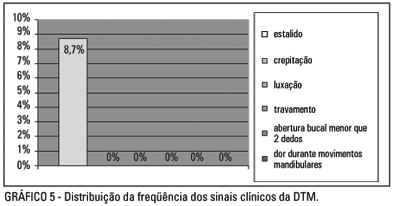AIM: to assess the frequency of signs and symptoms of the parafunctional habits and of the occlusal characteristics of 80 children, patients of the Preventive Orthodontics Clinic at Araçatuba’s Faculty of Dentistry - UNESP. METHODS: the clinical test comprised evaluation of the patient’s occlusal characteristics and observation of the presence of parafunctional habits. The children were submitted to a parent-supervised interview, whose questions were related to the signs and symptoms of the dysfunction. RESULTS AND CONCLUSION: we concluded that the most frequent signs and symptoms were teeth-grinding, headache and ATM noises. The most prevalent parafunctional habits were onicophagy and bruxism. The frequency of signs and symptoms of temporomandibular dysfunction can be noticed in children through interview and a detailed clinical test.
Temporomandibular joint; Temporomandibular dysfunction; Parafunctional habits





